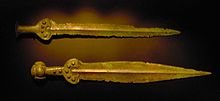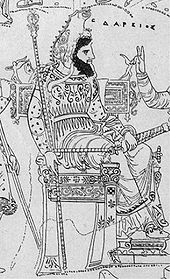Prehistoric and ancient history[edit]
The first weapons that can be described as "swords" date to around 3300 BC. They have been found in Arslantepe, Turkey, are made from arsenical bronze, and are about 60 cm (24 in) long.[2][3] Some of them are inlaid with silver.
Bronze Age[edit]
The sword developed from the knife or dagger. A knife is unlike a dagger in that a knife has only one cutting surface, while a dagger has two cutting surfaces. When the construction of longer blades became possible, from the late 3rd millennium BC in the Middle East, first in arsenic copper, then in tin-bronze.
Blades longer than 60 cm (24 in) were rare and not practical until the late Bronze Age because the Young's modulus of bronze is relatively low, and consequently longer blades would bend easily. The development of the sword out of the dagger was gradual; the first weapons that can be classified as swords without any ambiguity are those found in Minoan Crete, dated to about 1700 BC, reaching a total length of more than 100 cm. These are the "type A" swords of the Aegean Bronze Age.
One of the most important, and longest-lasting, types swords of the European Bronze Age was the Naue II type (named for Julius Naue who first described them), also known as Griffzungenschwert (lit. "grip-tongue sword"). This type first appears in c. the 13th century BC in Northern Italy (or a general Urnfield background), and survives well into the Iron Age, with a life-span of about seven centuries. During its lifetime, metallurgy changed from bronze to iron, but not its basic design.
Naue II swords were exported from Europe to the Aegean, and as far afield as Ugarit, beginning about 1200 BC, i.e. just a few decades before the final collapse of the palace cultures in the Bronze Age collapse.[4] Naue II swords could be as long as 85 cm, but most specimens fall into the 60 to 70 cm range. Robert Drews linked the Naue Type II Swords, which spread from Southern Europe into the Mediterranean, with the Bronze Age collapse.[5] Naue II swords, along with Nordic full-hilted swords, were made with functionality and aesthetics in mind.[6] The hilts of these swords were beautifully crafted and often contained false rivets in order to make the sword more visually appealing. Swords coming from northern Denmark and northern Germany usually contained three or more fake rivets in the hilt.[7]
Sword production in China is attested from the Bronze Age Shang Dynasty.[8] The technology for bronze swords reached its high point during the Warring States period and Qin Dynasty. Amongst the Warring States period swords, some unique technologies were used, such as casting high tin edges over softer, lower tin cores, or the application of diamond shaped patterns on the blade (see sword of Goujian). Also unique for Chinese bronzes is the consistent use of high tin bronze (17–21% tin) which is very hard and breaks if stressed too far, whereas other cultures preferred lower tin bronze (usually 10%), which bends if stressed too far. Although iron swords were made alongside bronze, it was not until the early Han period that iron completely replaced bronze.[9]
In the Indian subcontinent, earliest available Bronze age swords of copper were discovered in the Indus Valley Civilization sites in the northwestern regions of South Asia. Swords have been recovered in archaeological findings throughout the Ganges-Jamuna Doab region of Indian subcontinent, consisting of bronze but more commonly copper.[10] Diverse specimens have been discovered in Fatehgarh, where there are several varieties of hilt.[10] These swords have been variously dated to times between 1700–1400 BC, but were probably used more in the opening centuries of the 1st millennium BC.[10]
Iron Age[edit]
Iron became increasingly common from the 13th century BC. Before that the use of swords was less frequent. The iron was not quench-hardenedalthough often containing sufficient carbon, but work-hardened like bronze by hammering. This made them comparable or only slightly better in terms of strength and hardness to bronze swords. They could still bend during use rather than spring back into shape. But the easier production, and the better availability of the raw material for the first time permitted the equipment of entire armies with metal weapons, though Bronze Age Egyptian armies were sometimes fully equipped with bronze weapons.[11]
Ancient swords are often found at burial sites. The sword was often placed on the right side of the corpse. Many times the sword was kept over the corpse. In many late Iron Age graves, the sword and the scabbard were bent at 180 degrees. It was known as killing the sword. Thus they might have considered swords as the most potent and powerful object.[12]
In the summer of 2018, an eight-year-old girl found a sword in a scabbard (mistranslated into English by google as swordskid in the original press release page [13] see also the English language account given by the father of said eight-year-old[14]) made from wood and leather, which is determined to be from the Iron Age, in Lake Vidösten in Scandinavia.[15]
Greco-Roman antiquity[edit]
By the time of Classical Antiquity and the Parthian and Sassanid Empires in Iran, iron swords were common. The Greek xiphos and the Roman gladius are typical examples of the type, measuring some 60 to 70 cm (24 to 28 in).[16][17] The late Roman Empire introduced the longer spatha[18] (the term for its wielder, spatharius, became a court rank in Constantinople), and from this time, the term longsword is applied to swords comparatively long for their respective periods.[19]
Swords from the Parthian and Sassanian Empires were quite long, the blades on some late Sassanian swords being just under a metre long.
Swords were also used to administer various physical punishments, such as non-surgical amputation or capital punishment by decapitation. The use of a sword, an honourable weapon, was regarded in Europe since Roman times as a privilege reserved for the nobility and the upper classes.[20]
The Periplus of the Erythraean Sea mentions swords of Indian iron and steel being exported from ancient India to Greece.[21] Blades from the Indian subcontinent made of Damascus steel also found their way into Persia.[21]
Persian antiquity[edit]
In the first millennium BC the Persian armies used a sword that was originally of Scythian design called the akinaka (acinaces). However, the great conquests of the Persians made the sword more famous as a Persian weapon, to the extent that the true nature of the weapon has been lost somewhat as the name Akinaka has been used to refer to whichever form of sword the Persian army favoured at the time.
It is widely believed that the original akinaka was a 14 to 18 inch double-edged sword. The design was not uniform and in fact identification is made more on the nature of the scabbard than the weapon itself; the scabbard usually has a large, decorative mount allowing it to be suspended from a belt on the wearer’s right side. Because of this, it is assumed that the sword was intended to be drawn with the blade pointing downwards ready for surprise stabbing attacks.
In the 12th century, the Seljuq dynasty had introduced the curved shamshir to Persia, and this was in extensive use by the early 16th century.
Chinese antiquity[edit]
Chinese iron swords made their first appearance in the later part of the Western Zhou Dynasty, but iron and steel swords were not widely used until the 3rd century BC Han Dynasty.[9] The Chinese Dao (刀 pinyin dāo) is single-edged, sometimes translated as sabre or broadsword, and the Jian (劍 or 剑 pinyin jiàn) is double-edged. The zhanmadao (literally "horse chopping sword"), an extremely long, anti-cavalry sword from the Song dynastyera.







0 Comments